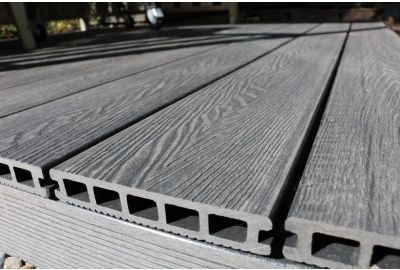Artificial decking - the facts
WHAT IS COMPOSITE DECKING?
In short, it’s a wood decking alternative that’s designed to be stronger and last longer. Our composite decking is made as a blend of both timber and PVC, which is intended to ensure that it has a natural feel to the final product, but it can also take on-board the advantages of being a PVC product – see below for more information.
Composite decking is made mainly from recycled plastics and wood (sawdust, shavings and the like). The idea behind this is to make it both eco-friendly and help give it the look of natural wood grain; the exact volume of each can vary by manufacturer depending on the effect they are trying to achieve.
Composite decking can make a superb addition to any property, whether it's resident for personal use or commercially installed.
For a long time, traditional timber decking was the most popular choice. Older styles of uPVC decking resulted in an unattractive product, despite the benefits. It was only in the mid-1990s that PVC manufacturers began to make products that looked as good as their competitors, and from there the composite decking market keeps growing.
Composite decking can be installed during any season without any adjustments needing to be made for doing so – and in fact we’d suggest having your deck installed during the colder months of the year. While it’s preferable to have your deck installed during the warmer spring and summer months, the problem is that this is when everyone begins their search for a deck! This can lead to massive waiting lists as you compete with everyone else looking for a new deck. By looking a few months ahead, you might be able to save considerable time and cost by having your deck installed during quieter months.
One thing we’d absolutely insist on: use only the manufacturer’s instructions, fittings, guidelines, etc. during installation. Not only does this ensure your deck is fitted to their precise requirements and gives the longest life for your product, but it also keeps your deck under warranty for the full 10 years; an incorrectly installed deck can void it.
So, what are the advantages and disadvantages of composite decking?
ADVANTAGES
- Less maintenance. Wooden decking can require large levels of care to clean and keep looking good, owing to the material – and it’s not a simple case of buying a replacement wooden board if something should break, either. uPVC decking, on the other hand, doesn’t require much at all – a quick clean here and there; the material isn’t prone to damage from cleaning like wood, and should you need a replacement, the old one can be pulled up and a new one installed quickly.
- Product strength and resilience. Wooden decking can split, rot, expand, wear, decay and break down as time goes on, no matter how well it’s treated before installation. Composite decking is much more resilient, designed to be much tougher and last longer than wood.
- Variety. “Traditional” wooden decking is designed to look like wood, i.e., a shade of brown: to artificially colour it would hide the advantage of having it, not to mention it’d harm the material. With composite decking, it can come in these shades, but there are other options – black or grey, for example, such as what GBP sells. This colouring process doesn’t harm the product; it’s factored into how it’s manufactured.
- Lifespan. Composite decking can last around 25 years, which is great, especially when compared to wooden decking, which can last less than half as long – this can be attributed to its water resistance, as traditional wooden decking is susceptible to water damage, causing it to erode, rot, split, etc.
- Scratch resistance. Our composite decking is resistant to scratches and surface damage.
- UV protection. Our composite wood is treated to naturally adapt to the sun’s rays, causing it to keep its colour no matter how warm it gets. Even when it gets warm, it’s not going to discolour. If it’s too hot to walk on, a simple cool-down from a hose or covering up the affected area with a cover, gazebo, parasol and the like is all that's needed.
- 10 year guarantee. All our decking comes with a 10-year manufacturer’s guarantee as standard; however you can expect your decking to last for much longer than this.
DISADVANTAGES
- Up-front cost. There’s no denying that a composite deck is a premium product, and you do pay for all the advantages such as resilience, less maintenance, anti-slip properties and more up-front. The cost will even out over a longer period by cutting out the time and labour that would have been spent on stripping, sanding, oiling, sealing, cleaning, and more, but composite decking must be seen as a long-term investment.
- No repainting/recolouring. The colour deck you choose has to be one you can see yourself being happy with for years to come – they are coloured during the manufacturing process to give the best anti-fading qualities possible. They can be changed by using harsh chemicals or sun bleaching, but this isn’t something we’d advise and it's likely to damage your deck.
- Realism. It might seem obvious, but when you have wood alternatives coloured grey, it loses the realistic feel of wood. It’s hard to see this as a negative, as the choice offered more than makes up for it (and you can buy traditionally coloured composite decking), but it’s worth mentioning.
GLOSSARY OF TERMS
Deck joists: Structural members that support the decking material above them.
Expansion/contraction: Getting bigger or getting smaller – this is something that happens with the wooden planks across all decks, and they need to be spaced accordingly.
Fasteners/fittings: Generic term for nails, bolts, screws and other connecting devices.
Grain: Describes the appearance of the interlocking wood fibres that give various wood species different looks and strength characteristics
Sub-Structure: The deck construction that is located below and supports the deck boards and railing system
Warp: a distortion in a material, caused by outside effects
For a long-lasting, low-maintenance, beautiful looking deck, you can’t go wrong with our composite decking range; see below for a full range of products in five phenomenal double-sided varities, each available in 3 metre- or 5 metre- lengths, along with all of the associated fittings.
Our branch and online staff are on hand to assist in any queries you may have – samples of the product are available upon request in branch or via our website.







